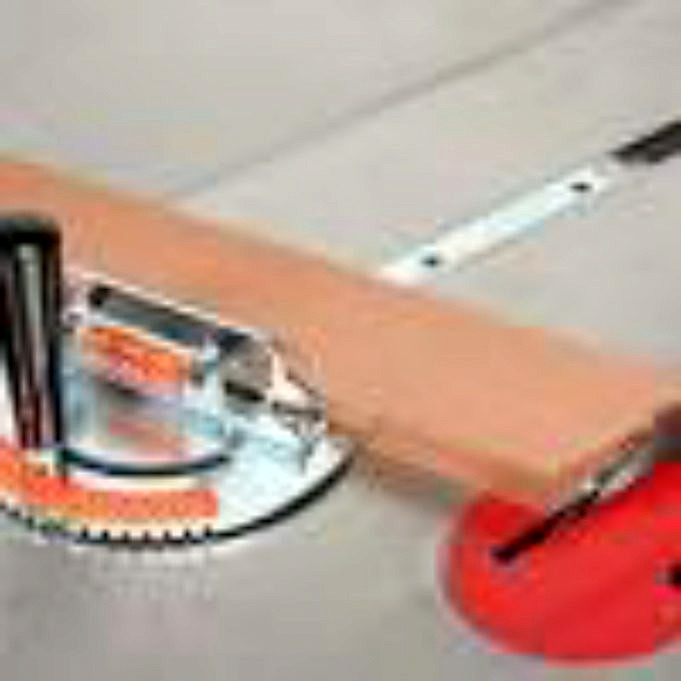Table saws are the perfect tool for cutting and ripping small to medium-sized pieces of lumber. The table saw will make great rips on its own cuts parallel to the wood grain. A miter gauge is a tool that can be added to your table saw so you can make perfect crosscuts.
Your table saw has lots of parts and pieces. Theres the rip fence, which is a cutting guide that runs across the table parallel to the blade. What about the miter gauge?
The miter gauge looks sort of like a fancy protractor stuck to your table saw. The miter gauge holds your material in place while guiding it at the angle you need to make your cut. The gauge has a full range from -45 to 45 degrees and locks firmly in place to keep your cut clean and neat every time.
Many table saws will come with their own miter gauges built-in, but there are tons that you can buy on the secondary market that are even more precise allowing you to create beautiful square, angled, and even compound crosscuts for your woodworking project. While theyre often more expensive, they make your final product much more clean, neat, and attractive. Impressive and skillful work takes the right tools for the job, and your miter gauge is a crucial part of your woodworking journey.
How To Use A Miter Gauge
All you have to do is line up the sheet with the straight end of the miter gauge. Then, push the pieces together with the miter gauge facing towards the saw blade. Your table saw will make a clean cut at the angle you set with the miter slot. Simply lock the saw and start cutting.
Miter gauges can make square cuts and angled cross-cuts along with all kinds of unique and special cuts.
Cross Cuts
The miter gauge can be used to make a cross-cut. Put the board against the straight part of the gauge as before. Draw a mark where you want your cut, and line it up with the saw blade. Turn on the motor, and move the miter gauge towards your blade. Keep the board aligned against the straight edge of the gauge. When youre done, pull the board out and away from the saw blade and pull the assembly back. Turn off the motor.
Square Cross Cuts
You can make a simple square cross-cut by setting to 0 (or sometimes your miter gauge might read 90) and making your cut. Youll get a nice clean straight cut across the board. Start your table saw unplugged to prepare it for use. Move the miter gauge so that it is in line with the blade of the stationary saw. To check that the gauge is accurate, you can place the edge from a combination saw against your miter gauge. If they align at 0, then your gauge is calibrated properly.
Angled Crosscuts
Of course, you can also make a nice clean angle by putting your gauge at 45 degrees. The process is the same, except that you need to hold the board against the miter gauge’s flat edge to achieve a smooth, even cut. You will need to use slightly less pressure when cutting angled crosscuts. However, it is important to keep your speed down and apply more pressure. The grain of the wood will tend to fight back at you more which can result in a less clean cut.
Compound Cuts
A compound cut is an angled crosscut at a beveled angle. This can be done in a variety of safe ways. Some table saws even allow you to adjust the bevel of your blade for this purpose.
Safety Tips
When making a crosscut, don’t use the fence with the miter gauge. There are no moving parts other than the tabletop. If you press the board against a fence, the saw may cause it to slide, kicking it into the air. If youre making any angled cross cuts, its recommended that you take off the fence or move it out of the way so you can use your miter gauge.
Dont perform crosscuts on boards that are more than 1.2 m long with your table saw and miter gauge. You will need a larger tool to handle the bigger jobs. Most table saws are too small to cut lumber at this size.
As always, make sure to wear the proper safety gear and work with your fingers away from the blade. Take off any jewelry or loose-fitting clothing, and don’t forget your safety glasses when you use your table saw.
Always be sure to exercise safe practices when working with power tools. It can be a good idea to watch an instructional video if youve never used a miter gauge to get an even better concept of how to operate one.
To ensure clean edges and secure joints, measure and calculate each piece twice before you cut. You should sand your cuts to smoothen them. Any debris or uneven surfaces can compromise the integrity of your final project.



